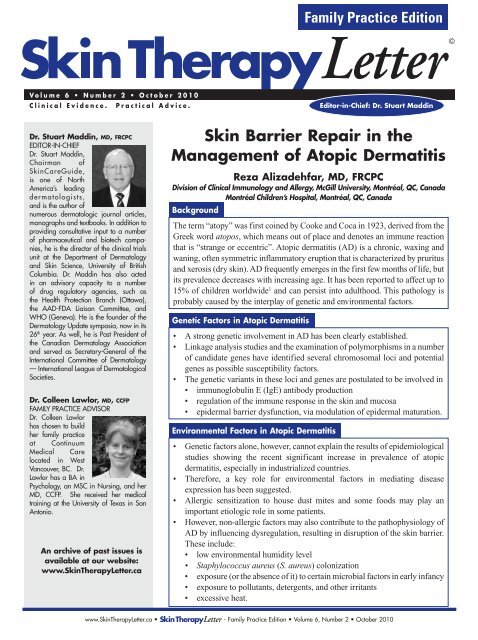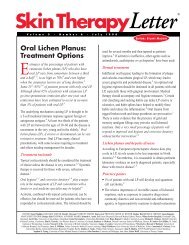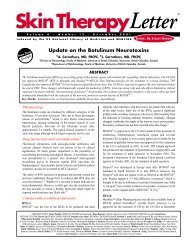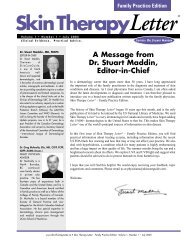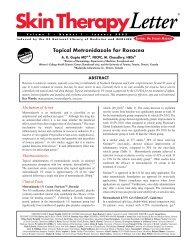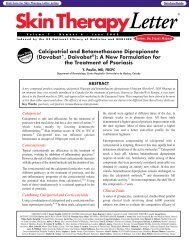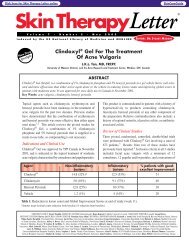PDF English - Skin Therapy Letter
PDF English - Skin Therapy Letter
PDF English - Skin Therapy Letter
Create successful ePaper yourself
Turn your PDF publications into a flip-book with our unique Google optimized e-Paper software.
Family Practice Edition<br />
V o l u m e 6 • N u m b e r 2 • O c t o b e r 2 0 1 0<br />
C l i n i c a l E v i d e n c e . P r a c t i c a l A d v i c e .<br />
Editor-in-Chief: Dr. Stuart Maddin<br />
Dr. Stuart Maddin, md, frcpc<br />
EDITOR-IN-CHIEF<br />
Dr. Stuart Maddin,<br />
Chairman of<br />
<strong>Skin</strong>CareGuide,<br />
is one of North<br />
America’s leading<br />
dermatologists,<br />
and is the author of<br />
numerous dermatologic journal articles,<br />
monographs and textbooks. In addition to<br />
providing consultative input to a number<br />
of pharmaceutical and biotech companies,<br />
he is the director of the clinical trials<br />
unit at the Department of Dermatology<br />
and <strong>Skin</strong> Science, University of British<br />
Columbia. Dr. Maddin has also acted<br />
in an advisory capacity to a number<br />
of drug regulatory agencies, such as<br />
the Health Protection Branch (Ottawa),<br />
the AAD-FDA Liaison Committee, and<br />
WHO (Geneva). He is the founder of the<br />
Dermatology Update symposia, now in its<br />
26 th year. As well, he is Past President of<br />
the Canadian Dermatology Association<br />
and served as Secretary-General of the<br />
International Committee of Dermatology<br />
— International League of Dermatological<br />
Societies.<br />
Dr. Colleen Lawlor, md, ccfp<br />
FAMILY PRACTICE ADVISOR<br />
Dr. Colleen Lawlor<br />
has chosen to build<br />
her family practice<br />
at Continuum<br />
Medical Care<br />
located in West<br />
Vancouver, BC. Dr.<br />
Lawlor has a BA in<br />
Psychology, an MSC in Nursing, and her<br />
MD, CCFP. She received her medical<br />
training at the University of Texas in San<br />
Antonio.<br />
An archive of past issues is<br />
available at our website:<br />
www.<strong>Skin</strong><strong>Therapy</strong><strong>Letter</strong>.ca<br />
<strong>Skin</strong> Barrier Repair in the<br />
Management of Atopic Dermatitis<br />
Reza Alizadehfar, MD, FRCPC<br />
Division of Clinical Immunology and Allergy, McGill University, Montréal, QC, Canada<br />
Montréal Children’s Hospital, Montréal, QC, Canada<br />
Background<br />
The term “atopy” was first coined by Cooke and Coca in 1923, derived from the<br />
Greek word atopos, which means out of place and denotes an immune reaction<br />
that is “strange or eccentric”. Atopic dermatitis (AD) is a chronic, waxing and<br />
waning, often symmetric inflammatory eruption that is characterized by pruritus<br />
and xerosis (dry skin). AD frequently emerges in the first few months of life, but<br />
its prevalence decreases with increasing age. It has been reported to affect up to<br />
15% of children worldwide 1 and can persist into adulthood. This pathology is<br />
probably caused by the interplay of genetic and environmental factors.<br />
Genetic Factors in Atopic Dermatitis<br />
• A strong genetic involvement in AD has been clearly established.<br />
• Linkage analysis studies and the examination of polymorphisms in a number<br />
of candidate genes have identified several chromosomal loci and potential<br />
genes as possible susceptibility factors.<br />
• The genetic variants in these loci and genes are postulated to be involved in<br />
• immunoglobulin E (IgE) antibody production<br />
• regulation of the immune response in the skin and mucosa<br />
• epidermal barrier dysfunction, via modulation of epidermal maturation.<br />
Environmental Factors in Atopic Dermatitis<br />
• Genetic factors alone, however, cannot explain the results of epidemiological<br />
studies showing the recent significant increase in prevalence of atopic<br />
dermatitis, especially in industrialized countries.<br />
• Therefore, a key role for environmental factors in mediating disease<br />
expression has been suggested.<br />
• Allergic sensitization to house dust mites and some foods may play an<br />
important etiologic role in some patients.<br />
• However, non-allergic factors may also contribute to the pathophysiology of<br />
AD by influencing dysregulation, resulting in disruption of the skin barrier.<br />
These include:<br />
• low environmental humidity level<br />
• Staphylococcus aureus (S. aureus) colonization<br />
• exposure (or the absence of it) to certain microbial factors in early infancy<br />
• exposure to pollutants, detergents, and other irritants<br />
• excessive heat.<br />
www.<strong>Skin</strong><strong>Therapy</strong><strong>Letter</strong>.ca • - Family Practice Edition • Volume 6, Number 2 • October 2010
The Impairment of the Barrier Function<br />
• The epidermis of the skin functions not only as a<br />
physical and anatomical barrier, but also as a vast<br />
immunological organ.<br />
• This barrier constantly protects against the entry of<br />
different microbes, allergens, and irritants.<br />
• In AD, a dysfunctional skin barrier has been shown to<br />
provoke increased trans-epidermal water loss (TEWL),<br />
resulting in pronounced cutaneous dehydration.<br />
• Such a damaged barrier can allow allergens, microbes,<br />
and irritants to penetrate the skin and cause a proinflammatory<br />
reaction that typically characterizes AD.<br />
• The extent of barrier dysfunction strongly correlates<br />
with the degree of inflammation within AD lesions. 2<br />
• The stratum corneum (SC) of the skin has been<br />
compared to a brick wall, consisting of terminally<br />
differentiated keratinocytes (bricks) that are surrounded<br />
by a matrix of specialized lipids.<br />
• The major lipids in the SC are:<br />
• ceramides (50% by mass)<br />
• cholesterol (25% by mass)<br />
• fatty acids (10-20% by mass).<br />
• These elements create a barrier that helps to<br />
• keep water within the body<br />
• prevent the entrance of pathogens and allergens.<br />
Options for Management<br />
A range of treatments exist for atopic dermatitis, depending<br />
on the severity of the disease.<br />
Non-pharmacological Factors<br />
• Flare-ups of AD can be reduced by:<br />
• wearing soft cotton clothing<br />
• washing clothes with mild detergents<br />
• avoiding the use of fabric softeners<br />
• controlling the ambient temperature and humidity<br />
of the home<br />
• implementing avoidance measures to decrease<br />
exposure to dust mites in sensitized individuals<br />
• more rarely, avoiding specific foods in sensitized<br />
patients. If a food trigger is suspected, it may be<br />
useful to consult an allergist.<br />
• It is important to emphasize that no good evidence<br />
supports highly restrictive diets, which might have<br />
a significant psychological impact and can lead to<br />
malnutrition.<br />
• Educational programs have demonstrated significant<br />
improvement in AD severity and treatment satisfaction<br />
in intervention groups compared with control groups. 6<br />
Emollients<br />
• Emollients soften and soothe the skin.<br />
• They are petroleum based gels.<br />
• It has been shown that AD patients have reduced levels<br />
of the SC lipids (e.g., ceramides). 3,4<br />
• This barrier defect affects not only the involved, but<br />
also the uninvolved skin, which correlates with a<br />
decrease in the ceramide fraction of the SC.<br />
• Furthermore, the epidermal dysfunction in AD may<br />
also be attributable to several factors including:<br />
• an altered enzymatic activity<br />
• an altered pH of the skin<br />
• an impaired epidermal differentiation and an<br />
abnormal expression of structural proteins involved<br />
in the cornification process.<br />
• Genetic abnormalities in protease inhibitor expression<br />
and reduced levels of cornified envelope proteins, such<br />
as filaggrin, 5 fuel the skin damage seen in eczematoid<br />
conditions.<br />
• Stress may also aggravate this barrier dysfunction by<br />
the production of endogenous glucocorticoids, which<br />
suppress epidermal lipid synthesis.<br />
• The skin barrier is further damaged by exposure to<br />
proteases from house dust mites and S. aureus.<br />
• Lastly, the intense itching and extensive scratching that<br />
is associated with AD can also be an important factor<br />
leading to the disruption of the cutaneous barrier.<br />
• There is no strong evidence that emollients improve<br />
AD directly.<br />
• However, emollients are widely recommended because<br />
they improve the appearance and symptoms of dry<br />
skin that is commonly present in AD. 7<br />
• Studies have shown that emollients may reduce the<br />
need for topical steroids and enhance the therapeutic<br />
response to them. 8,9<br />
• In the absence of good studies showing the superiority<br />
of one emollient over another, patient preference<br />
should guide their usage.<br />
Topical Corticosteroids<br />
• For several decades, topical corticosteroids have been<br />
the mainstay of treatment for AD flare-ups.<br />
• A number of agents are available in various vehicles,<br />
potencies, and concentrations.<br />
• Low-potency agents should be used in infants and on<br />
sensitive skin areas (e.g., face, neck, groin, and axillae)<br />
in order to minimize side-effects, such as skin atrophy,<br />
acne, and adverse systemic effects.<br />
• Topical corticosteroids should be used for the shortest<br />
duration and at the lowest potency possible, while<br />
still allowing good control of flare-ups, in order to<br />
minimize adverse effects.<br />
2 www.<strong>Skin</strong><strong>Therapy</strong><strong>Letter</strong>.ca • - Family Practice Edition • Volume 6, Number 2 • October 2010
Options for Management (continued)<br />
• Conversely, misinformed patients and/or parents<br />
demonstrating steroid phobia should be informed<br />
that withholding appropriate treatment affects their/<br />
their children’s wellbeing and unnecessarily prolongs<br />
the course of sometimes debilitating disease.<br />
Topical Calcineurin Inhibitors (TCIs)<br />
• TCIs are indicated in the management of<br />
• mild to moderate AD (pimecrolimus)<br />
• moderate to severe AD (tacrolimus).<br />
• TCIs inhibit T cell activation and release of cytokines<br />
involved in the pro-inflammatory cascade of AD.<br />
• Their side-effects include skin irritation and burning at<br />
the start of therapy, but usually subside with time.<br />
• Their long-term safety is unknown and amid rare<br />
reports of malignancies they should only be used in<br />
patients who are unresponsive or show unacceptable<br />
side-effects with classic therapy. 10,11<br />
Oral Antihistamines<br />
• There has been a lack of evidence supporting the use<br />
of sedative or non-sedative antihistamines for the<br />
treatment of atopic dermatitis.<br />
• The first generation antihistamines (diphenhydramine<br />
and hydroxyzine) are sometimes recommended at<br />
night for their sedative effects.<br />
Antimicrobial Agents<br />
• Secondary superinfection with S. aureus is common<br />
and is treated with short courses of antibiotics with<br />
anti-staphylococcus coverage.<br />
• Antiseptic baths have been advocated by some experts<br />
in those chronically colonized.<br />
Barrier Repair Creams<br />
• Given the importance of the dysregulated barrier<br />
function in AD, the use of topical agents aimed<br />
at accelerating its improvement represents a new<br />
therapeutic approach.<br />
• As important as emollients are for the alleviation of AD<br />
symptoms, these agents may be ineffective at correcting<br />
TEWL and the ceramide deficiency resulting from the<br />
defective skin barrier of AD patients.<br />
• The efficacy and tolerability of new ceramide-dominant<br />
skin repair creams with a more physiologic 3:1:1 ratio<br />
of ceramides, free fatty acids, and cholesterol have<br />
been studied in two company sponsored trials. 12,13<br />
• In one multicenter, investigator-blinded, randomized<br />
pediatric study using EpiCeram ® skin barrier cream,<br />
similar efficacy was demonstrated when compared<br />
with the mid-potency steroid fluticasone propionate<br />
0.05%. 12 No significant adverse events were observed<br />
in either treatment arms. However, 4 of 59 patients in<br />
the barrier group experienced an initial flare-up that<br />
required short-term fluticasone cream.<br />
• EpiCeram ® , a steroid-free, lipid-based barrier repair<br />
cream was approved by Health Canada in September<br />
2009 and is only available by prescription. Use is<br />
indicated for AD patients ≥6 months of age.<br />
• Studies on concomitant use of both topical steroids<br />
and skin barrier repair creams are not yet available.<br />
Conclusion<br />
Because of the better appreciated role of the skin barrier in AD disease pathogenesis, use of agents that can stabilize<br />
epidermal defenses may reduce the current exclusive dependence on topical steroids and immunomodulators. These<br />
barrier repair creams do not target inflammation directly, but rather act at an earlier stage in the disease process to<br />
normalize the barrier function and reduce pro-inflammatory signaling. This approach could potentially lead to better<br />
treatment outcomes with lesser side-effects.<br />
References<br />
1. Williams H, et al. J Allergy Clin Immunol 103(1 Pt 1):<br />
125-38 (1999 Jan).<br />
2. Lebwohl M, et al. Cutis 76(6 Suppl):7-12 (2005 Dec).<br />
3. Imokawa G. J Am Acad Dermatol 45(1 Suppl):S29-32<br />
(2001 Jul).<br />
4. Pilgram GS, et al. J Invest Dermatol 117(3):710-7<br />
(2001 Sep).<br />
5. Palmer CN, et al. Nat Genet 38(4):441-6 (2006 Apr).<br />
6. Staab D, et al. Pediatr Allergy Immunol 13(2):84-90<br />
(2002 Apr).<br />
7. Hanifin JM, et al. J Am Acad Dermatol 50(3):391-404<br />
(2004 Mar).<br />
8. Lucky AW, et al. Pediatr Dermatol 14(4):321-4 (1997<br />
Jul-Aug).<br />
9. Kantor I, et al. Today Ther Trends 11:157-66 (1993).<br />
10. US FDA Alert for Healthcare Professionals:<br />
Pimecrolimus. Available at: http://www.fda.gov/Drugs/<br />
DrugSafety/PostmarketDrugSafetyInformationforPatients<br />
andProviders/ucm153525.htm. Accessed: August 2, 2010.<br />
11. US FDA Information for Healthcare Professionals:<br />
Tacrolimus. Available at: http://www.fda.gov/Drugs/<br />
DrugSafety/PostmarketDrugSafetyInformationforPatients<br />
andProviders/ucm126497.htm. Accessed: August 2, 2010.<br />
12. Chamlin SL, et al. J Am Acad Dermatol 47(2):198-208<br />
(2002 Aug).<br />
13. Sugarman JL, et al. J Drugs Dermatol 8(12):1106-11<br />
(2009 Dec).<br />
www.<strong>Skin</strong><strong>Therapy</strong><strong>Letter</strong>.ca • - Family Practice Edition • Volume 6, Number 2 • October 2010<br />
3
Family Practice Edition<br />
Introduction<br />
Head Lice: A Review of Topical Therapies<br />
and Rising Pediculicidal Resistance<br />
Jason Sneath, MD 1 and John W. Toole, MD, FRCPC 2<br />
1<br />
Department of Dermatology and <strong>Skin</strong> Science, University of British Columbia, Vancouver, BC, Canada<br />
2<br />
Section of Dermatology, University of Manitoba, Winnipeg, MB, Canada<br />
Head lice infestations (Pediculosis capitis) are a worldwide problem with prevalence estimates typically ranging between<br />
1-3% in elementary school aged children. 1,2 Although this obligate parasite is a nuisance, infestation does not pose a<br />
health risk. Infestations tend to occur more frequently in females, 3 and less frequently in black children, 4 as it may be<br />
more difficult for lice to grasp their oval-shaped hair shafts. It is not associated with poor hygiene. Infestation occurs<br />
across all levels of society, but occurs more frequently under conditions of overcrowding. Recent evidence suggests<br />
increasing frequency of topical treatment failure may be related to a growing resistance to the neurotoxic pediculicides<br />
that have been the first-line treatment for the last 40 years. 5 Herein, we will review the current topical treatment options,<br />
including newer non-pediculicidal options.<br />
Overview of Facts on Lice<br />
• Pediculus humanus capitis (the head louse) is a<br />
2-4 mm blood sucking, wingless insect.<br />
• A louse cannot jump, but rather has 6 legs adapted for<br />
crawling along hairs at 23 cm per minute. 6<br />
• A louse will feed every 3-6 hours.<br />
• Prior to feeding, the louse injects saliva into the skin.<br />
• The life span is approximately 4 weeks and the female<br />
lays 6-8 eggs per day.<br />
Diagnosis and Symptoms<br />
Many affected individuals report no symptoms, but the<br />
most commonly reported symptom is scalp pruritus. 8 The<br />
pruritus is thought to be caused by hypersensitivity to the<br />
louse saliva that is injected into the scalp during feeding,<br />
but the itching often does not begin until 1-4 weeks<br />
after infestation. Although any part of the scalp may be<br />
colonized, there seems to be a predilection for the nape of<br />
the neck and post-auricular areas.<br />
<strong>Skin</strong> Findings<br />
• Often there are no significant findings on the skin.<br />
• Pruritic, papular lesions may be found at the nape of<br />
the neck.<br />
• There may be excoriations on the scalp.<br />
• Secondary staphylococcal infection is possible.<br />
• Possible enlargement of cervical / nuchal lymph nodes.<br />
Hair Findings<br />
• True infestation is confirmed by the presence of live<br />
adult lice or nymphs (hatched immature lice) present<br />
on the scalp with nits.<br />
• The presence of nits alone does not confirm infestation,<br />
as an empty nit can remain cemented to a hair even<br />
after the infestation has cleared.<br />
• Eggs hatch in 8 days, leaving their shell (“nit”)<br />
cemented to the base of the hair.<br />
• Head lice spread by head contact, shared fabrics,<br />
shared combs, and other fomites that are commonly in<br />
contact with the scalp and hair. 7<br />
• A louse can survive 2-3 days away from a human host.<br />
• Pets are not vectors.<br />
• The distance of the nit from the scalp can be a clue to<br />
the duration of the infestation, as it moves with the hair<br />
away from the scalp when hair grows.<br />
• A nit within 0.6 mm of the scalp is usually a viable egg.<br />
Diagnosis is best made by wet or dry combing the scalp<br />
with a fine-toothed nit comb with teeth spaced 0.2 mm<br />
apart. One study comparing wet combing with visual<br />
inspection found that wet combing accurately diagnosed<br />
infestation 90.5% of the time, as compared to 28.6% with<br />
visual inspection. 2<br />
Directions for Detection by Wet Combing 9<br />
• Saturate hair with a conditioner.<br />
• Remove tangles with a regular comb.<br />
• With the nit comb against the scalp, comb to the end<br />
of the hair.<br />
• Check the comb for lice after each pull by visual<br />
inspection and by cleaning the comb with a tissue and<br />
inspecting the contents.<br />
• Dispose of the tissue in a plastic bag.<br />
• Comb the entire scalp at least 5 times.<br />
• Seal the plastic bag and dispose of it.<br />
• If infestation is confirmed, rinse off all conditioner<br />
prior to treatment.<br />
4 www.<strong>Skin</strong><strong>Therapy</strong><strong>Letter</strong>.ca • - Family Practice Edition • Volume 6, Number 2 • October 2010
Treatment Options<br />
Method Treatment Application Comments<br />
Topical<br />
Non-pediculicides<br />
Topical<br />
Pediculicides<br />
Isopropyl<br />
myristate<br />
50% rinse<br />
Herbal remedy<br />
(HairClean 1-2-3)<br />
Permethrin cream<br />
(1% or 5%)<br />
Pyrethrin 0.33%<br />
+ Piperonyl<br />
butoxide 4%<br />
Lindane (1%<br />
gamma benzene<br />
hexachloride)<br />
Table 1: Topical treatment options for head lice 9-13<br />
• 30-120 mL of solution is<br />
applied to dry hair and<br />
scalp (especially nape of<br />
the neck); leave for 10<br />
minutes<br />
• Comb wet hair with nit<br />
comb and wash with<br />
shampoo<br />
• Apply product to scalp<br />
and hair; leave for 15<br />
minutes before rinsing<br />
• Applied 3 times with<br />
5-day intervals between<br />
applications<br />
• Wash hair with<br />
conditioner-free shampoo<br />
and towel dry<br />
• Apply product to scalp<br />
and hair for 10 minutes<br />
before rinsing (25 mL)<br />
• Comb wet hair with nit<br />
comb<br />
• Repeat in 7 days<br />
• Apply product to dry hair<br />
for 10 minutes, then add<br />
water to form lather<br />
• Rinse, do not use<br />
conditioner<br />
• Repeat in 7 days<br />
• Apply product to dry hair<br />
that is free of conditioner,<br />
gel or hairspray<br />
• Rub into hair and scalp<br />
until wet and leave in<br />
place for 4 minutes<br />
• Rinse, being careful not<br />
to spread the product to<br />
other body sites<br />
• Works by dissolving the outer layer of the<br />
exoskeleton of a louse<br />
• Resistance less likely due to mechanical<br />
mechanism<br />
• 2 applications usually necessary 7-10 days apart<br />
• Approved for use in patients ≥2 years of age<br />
• May cause erythema, burning, and dry scalp 10<br />
• Herbal product containing anise, coconut, ylang<br />
ylang oil, and isopropyl alcohol<br />
• Suggested mechanism is to invoke a “flee<br />
response” by creating an undesirable<br />
environment for the louse 9<br />
• One manufacturer sponsored study in Israel<br />
found similar effectiveness (92%) when<br />
compared with pediculicide containing<br />
permethrin, malathion, and piperonyl butoxide 11<br />
• Synthetic pyrethroid, neurotoxic to lice, but low<br />
neurotoxicity in humans<br />
• 1% preparation is available OTC<br />
• Not ovicidal, therefore requires retreatment<br />
7-10 days later<br />
• Approved for use in patients >2 years of age<br />
• May cause itching or burning of the scalp<br />
• Made from chrysanthemum extract, neurotoxic<br />
to lice but low neurotoxicity in humans<br />
• Avoid if there is a known chrysanthemum or<br />
ragweed allergy<br />
• Approved for use in patients >2 years of age<br />
• May cause itching or burning of the scalp<br />
• Organophosphate, neurotoxic to lice and<br />
humans<br />
• Second-line treatment due to the risk of<br />
toxicity, which can lead to seizures 12<br />
• Contraindicated in patients
Management (continued)<br />
In recognition of the developing resistance, there has been an increased interest within Canada to explore effective nonpediculicidal<br />
options. A recent study found the efficacy of isopropyl myristate 50% to be significantly higher (57%) than<br />
the standard treatment with pyrethrin 0.33% + piperonyl butoxide 4%. 10<br />
While non-pediculicidal therapy may be efficacious against treatment resistant infestations, re-infestation from close<br />
contacts and fomite transmission is a common problem. Along with treatment, it is important to decontaminate the<br />
environment.<br />
Environmental Decontamination 14<br />
• Family members and close contacts should be examined and be treated for any infestation.<br />
• Any clothing, linens, combs, toys, and fabrics used by the individuals in the 3 days preceding treatment should be<br />
decontaminated.<br />
• Fabrics can be washed in high heat and put in a hot dryer for 20 minutes.<br />
• Items that cannot be washed can be sealed in a plastic bag for 14 days or placed in the freezer for 24 hours.<br />
• Brushes can be soaked in rubbing alcohol for 1 hour.<br />
• Floors and furniture can be cleaned by vacuuming.<br />
• Spraying the home with a pediculicide is not recommended.<br />
• No nit policies at schools are unnecessary.<br />
Management Tree<br />
Suspected Lice Infestation<br />
(scalp pruritus, papules at the nape of the neck, or known close contact with another infested individual)<br />
Examine scalp using fine-toothed nit comb (0.2 mm spacing)<br />
Wet hair with lubricant, such as hair conditioner (optional), and<br />
comb front to back with the comb against the scalp<br />
Confirm infestation<br />
By wet or dry combing (presence of live adult louse or nymph)<br />
Choose treatment<br />
(based on patient preference, age, and local resistance to topical<br />
pediculicides)<br />
Take measures to decrease risk of reinfestation and spread<br />
(treat all family members, notify school, and decontaminate<br />
environment)<br />
Manual Removal<br />
Some patients may prefer to attempt mechanical treatments prior to topical therapy. Wet combing, as described earlier,<br />
can be both diagnostic and therapeutic. To attempt this method the patient should wet comb the entire scalp until no more<br />
lice are found every 3-4 days for 3 weeks, or at least 2 weeks after the last adult louse was found. 14<br />
6 www.<strong>Skin</strong><strong>Therapy</strong><strong>Letter</strong>.ca • - Family Practice Edition • Volume 6, Number 2 • October 2010
Treatment Failure<br />
Treatment failure is commonly a result of inadequate or improper treatment, resistance, or reinfestation. If environmental<br />
decontamination was performed and the treatment was properly administered, then immediate retreatment with a different<br />
agent is advised.<br />
Conclusion<br />
Head lice infestation is a common problem for children in Canada. The first-line treatment of using topical pediculicides<br />
is unfortunately not as effective as it once was because of a heritable resistance that seems to be rising in prevalence.<br />
Topical non-pediculicides may be an effective option in the case of failed treatment due to louse resistance to standard<br />
treatment.<br />
References<br />
1. Harris J, et al. Commun Dis Public Health 6(3):246-9 (2003 Sep).<br />
2. Jahnke C, et al. Arch Dermatol 145(3):309-13 (2009 Mar).<br />
3. Counahan M, et al. J Paediatr Child Health 40(11):616-9 (2004 Nov).<br />
4. Centers for Disease Control and Prevention. Fact sheet: head lice. Available at: http://www.cdc.gov/lice/head/factsheet.html.<br />
Accessed June 28, 2010.<br />
5. Marcoux D, et al. J Cutan Med Surg 14(3):115-8 (2010 May-Jun).<br />
6. Ko CJ, et al. J Am Acad Dermatol 50(1):1-12 (2004 Jan).<br />
7. Burkhart CN, et al. J Am Acad Dermatol 56(6):1044-7 (2007 Jun).<br />
8. Mumcuoglu KY, et al. J Med Entomol 41(4):803-6 (2004 Jul).<br />
9. District Health Authority Public Health Services of Nova Scotia. Guidelines for treatment of pediculosis capitis (head lice),<br />
August 2008. Available at: http://www.gov.ns.ca/hpp/publications/Head Lice Guidelines for Treatment.pdf. Accessed July 3,<br />
2010.<br />
10. Kaul N, et al. J Cutan Med Surg 11(5):161-7 (2007 Sep-Oct).<br />
11. Mumcuoglu KY, et al. Isr Med Assoc J 4(10):790-3 (2002 Oct).<br />
12. US Food and Drug Administration public health advisory on lindane. Available at: http://www.fda.gov/Drugs/DrugSafety/<br />
PostmarketDrugSafetyInformationforPatientsandProviders/ucm110845.htm. Accessed July 4, 2010.<br />
13. Position Statement from Infectious Diseases and Immunization Committee, Canadian Paediatric Society. Paediatr Child Health<br />
13(8):692-704 (2008 Oct).<br />
14. Goldstein AO, et al. (2010 Jan). Available at: http://www.uptodate.com/home/index.html. Accessed July 3, 2010.<br />
View past issues<br />
Browse our archive of past issues at:<br />
www.<strong>Skin</strong><strong>Therapy</strong><strong>Letter</strong>.ca<br />
We welcome your feedback.<br />
Please email us with your comments and topic suggestions to:<br />
info@<strong>Skin</strong><strong>Therapy</strong><strong>Letter</strong>.com<br />
www.<strong>Skin</strong><strong>Therapy</strong><strong>Letter</strong>.ca • - Family Practice Edition • Volume 6, Number 2 • October 2010<br />
7
SIGN UP FOR YOUR FREE SUBSCRIPTION<br />
Family Practice Edition<br />
Editor-in-Chief: Dr. Stuart Maddin<br />
Go online to www.<br />
.ca and sign up today!<br />
To get more information, Canadian medical professionals and consumers can<br />
access all of our sites from www.<strong>Skin</strong>CareGuide.ca or go directly to:<br />
Patient sites:<br />
AcneGuide.ca BotoxFacts.ca ColdSores.ca DermatologyCare.ca<br />
EczemaGuide.ca FungalGuide.ca HerpesGuide.ca Lice.ca<br />
MildCleanser.ca MohsSurgery.ca PsoriasisGuide.ca PsoriaticArthritisGuide.ca<br />
RosaceaGuide.ca <strong>Skin</strong>CancerGuide.ca Sweating.ca UnwantedFacialHair.ca<br />
Medical professional sites:<br />
<strong>Skin</strong>Pharmacies.ca <strong>Skin</strong><strong>Therapy</strong><strong>Letter</strong>.ca Dermatologists.ca<br />
Social networking sites for patients and health care professionals:<br />
PsoriasisPatients.com<br />
We welcome your feedback. Please email us with your comments<br />
Graceway Pharmaceuticals LLC<br />
Aldara ® , Atopiclair ® , Benzig ® , and MetroGel-Vaginal ®<br />
Johnson & Johnson Inc.<br />
Aveeno ® , Neutrogena ® , Retin-A ® ,<br />
Retin-A Micro ® tretinoin gel (microsphere), 0.04%,<br />
Retin-A Micro ® tretinoin gel (microsphere), 0.1%, and Roc ®<br />
LEO Pharma Inc.<br />
Dovobet ® , Dovonex ® , Fucidin ® , and Xamiol ®<br />
Nycomed Canada Inc.<br />
Resultz ®<br />
and topic suggestions to: info@skintherapyletter.com<br />
The following companies have provided an unrestricted educational grant for the distribution of our 2010 publications:<br />
Pediapharm Inc.<br />
EpiCeram ® , Kool Effect ® Patch, NYDA ® , Suprax ® ,<br />
and Vapolyptus ® Patch<br />
Procter & Gamble<br />
Gillette ® , Head & Shoulders ® , Olay ® , Secret ® , and Tide ®<br />
Tribute Pharma Canada Inc.<br />
Soriatane ®<br />
Valeant Canada Limited<br />
Dermatix Ultra, Efudex ® , Glyquin ® XM, and Ultravate ®<br />
<strong>Skin</strong> <strong>Therapy</strong> <strong>Letter</strong> © - Family Practice Edition (ISSN 1911-7671) Copyright 2010 by <strong>Skin</strong>CareGuide.com Ltd. <strong>Skin</strong> <strong>Therapy</strong> <strong>Letter</strong> © - Family Practice Edition is published<br />
quarterly by <strong>Skin</strong>CareGuide.com Ltd, 1004-750 West Pender, Vancouver, British Columbia, Canada, V6C 2T8. All rights reserved. Reproduction in whole or in part by any<br />
process is strictly forbidden without prior consent of the publisher in writing. While every effort is made to see that no inaccurate or misleading data, opinions or statements<br />
appear in the <strong>Skin</strong> <strong>Therapy</strong> <strong>Letter</strong> © - Family Practice Edition, the Publishers, and Editorial Board wish to make it clear that the data and opinions appearing in the articles<br />
herein are the responsibility of the contributor. Accordingly, the Publishers, the Editorial Committee and their respective employees, officers, and agents accept no liability<br />
whatsoever for the consequences of any such inaccurate or misleading data, opinion, or statement. While every effort is made to ensure that drug doses and other quantities<br />
are presented accurately, readers are advised that new methods and techniques involving drug usage, and described herein, should be followed only in conjunction with<br />
the drug manufacturer’s own published literature.<br />
8 www.<strong>Skin</strong><strong>Therapy</strong><strong>Letter</strong>.ca • - Family Practice Edition • Volume 6, Number 2 • October 2010


